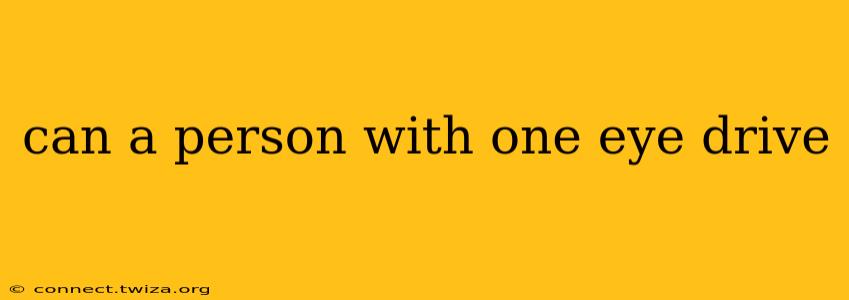The short answer is: yes, in most places, a person with one eye can legally drive, provided they meet certain requirements and demonstrate sufficient driving ability. However, the specifics vary depending on location and individual circumstances. This article will explore the legal aspects, the challenges faced by monocular drivers, and the adaptations they may employ to navigate the road safely.
What are the Legal Requirements for Driving with One Eye?
Most jurisdictions don't outright prohibit driving with one eye. Instead, the focus is on ensuring that individuals can safely operate a vehicle. This often involves undergoing a driving test, which may assess depth perception and field of vision. The exact requirements vary, so it's crucial to check with your local Driver and Vehicle Licensing Agency (DVLA) or equivalent organization. They will specify the visual acuity standards needed to obtain or retain a driving license. Some regions might require more frequent vision tests or additional assessments for monocular drivers.
How Does Having One Eye Affect Driving?
Driving with one eye presents some challenges compared to binocular vision. The primary concern is depth perception, which is crucial for judging distances accurately, especially when overtaking, parking, or navigating tight spaces. While a single eye can still provide a sense of depth, it's less precise. A reduced field of vision is another potential issue, limiting the peripheral awareness of surrounding vehicles and obstacles.
What are the Challenges Faced by Monocular Drivers?
- Depth Perception: Accurately judging distances to other vehicles and objects can be more difficult, potentially leading to misjudgments in overtaking maneuvers or when parking.
- Peripheral Vision: The loss of binocular vision can restrict peripheral vision, making it harder to detect vehicles or obstacles approaching from the sides.
- Increased Strain: Driving with one eye can lead to increased eye strain and fatigue, especially during longer journeys.
Can Monocular Drivers Compensate for the Limitations?
Yes, many monocular drivers successfully compensate for these limitations. They often develop compensatory driving techniques, such as:
- Increased Attention: Paying extra attention to their surroundings and driving more defensively.
- Slower Driving Speeds: Maintaining lower speeds to allow more reaction time.
- Avoiding Distractions: Minimizing distractions inside and outside the vehicle.
- Frequent Breaks: Taking regular breaks to avoid eye strain and fatigue.
What Adaptations Can Help Monocular Drivers?
While no special equipment is mandated, some adaptations might help:
- Adjusting Mirrors: Carefully adjusting vehicle mirrors to maximize the field of vision.
- Driving Practice: Extensive practice in varied driving conditions can build confidence and skills.
- Professional Driving Lessons: Consider professional driving lessons tailored to the needs of monocular drivers.
How Often Do I Need to Get My Eyes Checked?
The frequency of eye exams for monocular drivers may be more frequent than for those with two eyes. This is because the single eye needs to function optimally. Your local DVLA or equivalent organization will provide guidelines on this, but expect more regular checks.
What are the specific vision requirements for driving with one eye in [Specific Location]?
This question requires specifying the location. Driving regulations differ significantly between countries and even states or provinces. Check with the relevant authority in your specific location for precise details. For example, the DMV in California, the DVLA in the UK, or the equivalent agency in your country will have the most up-to-date information on vision requirements for driving.
This information is for general knowledge only and should not be considered medical or legal advice. Always consult with your doctor and the relevant driving licensing authority in your jurisdiction for personalized guidance.
